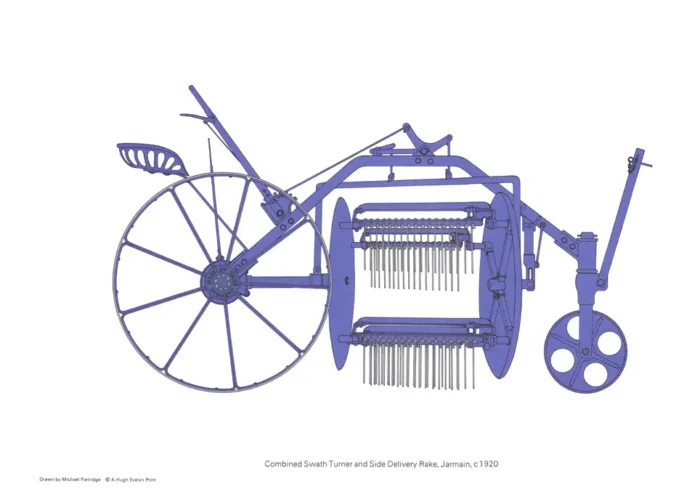Combined Swath Turner and Side Delivery Rake, Jarmain, c. 1920
£20.00
Combined Swath Turner and Side Delivery Rake, Jarmain, c. 1920 (scroll down for a more detailed Description)
Published 1969 by © Hugh Evelyn Limited; drawn by Michael Partridge
Size: 34 x 23 cm [13½″ x 9½″] may vary slightly from printers’ cut 50 years ago
Printed on high white matt heavy paper of 138 g/m2
Print is STANDARD size – shipping is the same for 1 to 10 prints (based on largest print size in your order) – see Shipping & Returns
In stock
Description
Little attempt was made to mechanise haymaking before the nineteenth century, all such work having been performed by hand for millennia. The first tedder noticed in England was made by Robert Salmon of Woburn. It comprised a main axle with two large wheels and two smaller wheels connected by wooden battens to create a horizontal cylinder around the main axle. Iron spikes were fixed to the battens which caught the cut grass then lifted it and tossed it. An efficient horse drawn drag-rake was made by Smith and Ashby of Stamford by the mid 1800’s and one made by Ransomes won first prize at the Royal Agricultural Show in 1857. This was an iron machine with individually sprung light steel teeth which could be raised or lowered. Nicholson’s double action haymaker (which cost 16 guineas) won first prize in its section at Salisbury also in 1857. The Haseley tedder, or kicker, was first demonstrated in 1899. It was an attempt to smooth out the violent jerking experienced with other machines with sprung forks fitted to crankshafts from the land wheels. In the early 20th Century the haykicker was very soon replaced with the swath turner of which the Jarmain was a prime example. It was in fact invented by one S.A Peto of Dover and the patent part-assigned to Mr Jarmain of Oxford.
Additional information
| Weight | 0.0118 kg |
|---|---|
| Dimensions | 35 × 24.5 cm |





